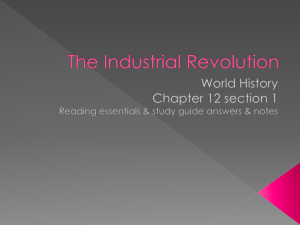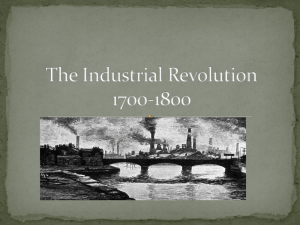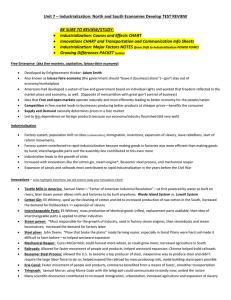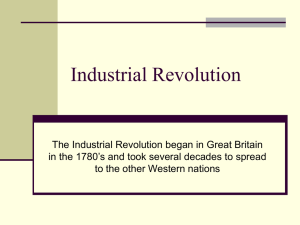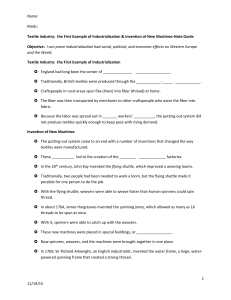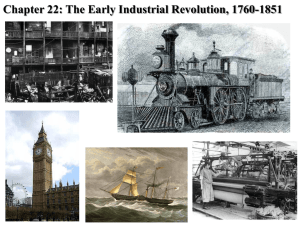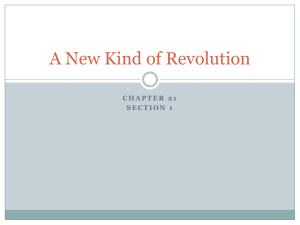Unit 12: Industrial Revolution
advertisement
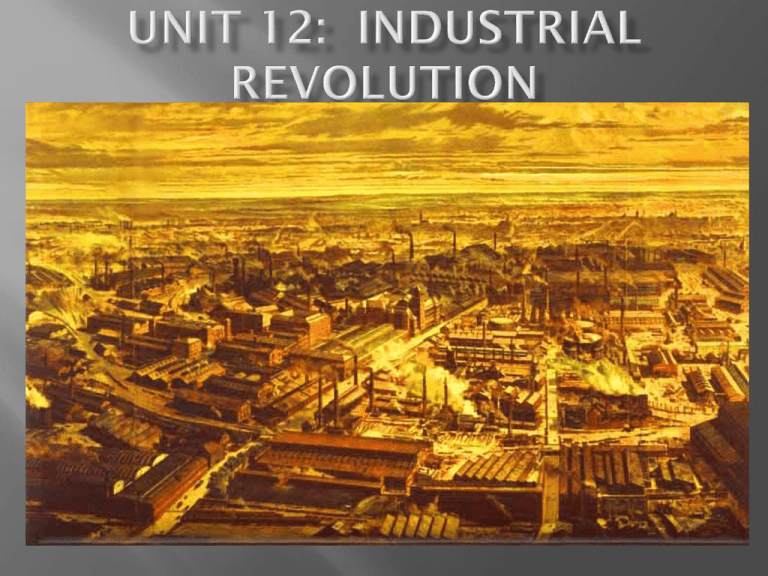
SSWH15 The student will be able to describe the impact of industrialization, the rise of nationalism, and the major characteristics of worldwide imperialism. a. Analyze the process and impact of industrialization in England, Germany, and Japan, movements for political reform, the writings of Adam Smith and Karl Marx, and urbanization and its effect on women. Era of rapid industrial development Practical application of knowledge gained from Scientific Revolution and Enlightenment Had a deeper understanding of the natural world Scientific advances were then applied in a practical way Led to creation of new machines and businesses Major developments in technology aimed at producing and moving goods Designed to meet needs of fast-growing population Agricultural Revolution had already taken place there Small farms combined into more efficient, larger holdings that were fenced off (enclosed). Tenant farmers moved to cities Farmers no longer needed permission from others to try new methods. Seed drill – planted seeds in straight rows Horse-drawn hoe broke up soil before planting Crop rotation – produced more crops, less land Increased production/less labor Iron plows replaced wooden More food at lower prices (people have money to buy manufactured goods) Had factors of production – land, labor, capital Government policies toward trade Rich supply of natural resources, especially coal and iron ore, rivers for power and shipping routes (land) Plenty of tools, machinery, equipment and inventory for production (capital), also money to invest (capital) Large supply of labor Free trade attitudes, encouraged development Not destroyed in Napoleonic Wars (island/isolated) TEXTILES Originally a cottage industry - Families made cloth in their homes (spinning and weaving) Mechanization Loom for weaving cloth (1733 – John Kay/Flying shuttle) Spinning Jenny (1760s – James Hargreaves) – 8 times the thread of a spinning wheel. - Water power to drive the machines (Richard Arkwright) in mill (1780s) - Water powered loom (1785 – Edmund Cartwright) - - One person could weave as much cloth as 200 hand loom operators. - With each new idea, other ideas followed. Prices of cotton cloth fell Demand for cotton went up Led to invention of the cotton gin (Eli Whitney) and more slave labor in the United States. 1712 – first steam engine (Thomas Newcomen) 1769 – improved steam engine (James Watt) Factory to manufacture steam engines Steam became the driving force of industrialization, no longer need to have water power to drive machines Henry Bessemer (British) and William Kelly (American) each came up with way to make steel cheaply and efficiently – burning off the impurities of iron. Steel – much stronger than iron Developed in 1870’s Brits worked with it in 1820’s/1830’s, developed a dynamo(electric generator) Late 1800’s found ways to use as a power source Thomas Edison 1879 Improved light bulb Transmission systems developed in 1882, put into use in NYC and London. Hydroelectric power Electric motors replaced steam power With increased demand for cotton, coal and iron - TRANSPORTATION became priority. 1804 first steam-powered locomotive 1814 steam locomotive that ran on rails By mid 1800s over 5,000 miles of track in Britain. Railroads Made shipping less expensive Expanded market for goods Steamboats Robert Fulton’s Clermont 1808 (American) 1830s first steamboat crossed the Atlantic About half the time (17 days) Regular service across the Atlantic began Ships built of iron and steel moved goods all over the world quickly and cheaply. Automobiles – late 1800’s Internal combustion engines (burned fuel in closed cylinder) 1893 first gas-powered auto in U.S. Airplanes – early 1900’s Orville and Wilbur Wright 1903 Samuel Morse – sent electric currents through a wire, communicated with clicking sounds to represent letters. (telegraph) Stretched across continents and oceans (1844) Alexander Graham Bell – telephone 1876 Guglielmo Marconi – wireless messages 1895 Did not have a central government to aid in industrial growth. Didn’t industrialize until the 1870’s (about 100 years after Britain) Within a few decades – strongest industrial power in Europe. German Customs House – got rid of trade barriers between German states, opened up a wider market. Railway technology helped with transport of coal. Profited from the British experience – could learn from their mistakes. (Don’t have to invent things.) Did invent dynamo to generate electricity. Isolated itself from outside ideas, lagged behind until after contact with Matthew Perry (mid-1800’s) Perry’s steam-powered ships impressed Japan Initially thought dragons were coming – saw the steam, didn’t know what it was. Industrialized rapidly after 1868. Emperor Meiji realized how far behind Japan was, that times had changed. (time of samurai and dragons had passed) Importing goods from U.S. and Britain Became aggressive about not importing, and producing own goods. Borrowed European technology and learned from European mistakes. Modernized military Paid attention to Germany Strong government Rich natural resources Rapidly increasing population Inventions that boosted agriculture Cotton gin and mechanical reaper Canals and railroads Steel and machinery industries boomed 1869 transcontinental railroad Population of Europe and America exploded World population doubled from 1800 to 1850 Decline in death, wars and diseases People were well-fed and healthier Famine in Europe and America practically disappeared. Factories for different industries opened all across Britain. New jobs/new labor system Workers on shifts, set hours, set duties Families went to work in factories (even women and kids) Factories not safe Society changed due to population shift Emergence of industrial middle class Shift in power from agriculture to manufacturing New, well-educated middle class People who built and managed the factories, bought machines, predicted markets Bankers, merchants, lawyers, doctors, engineers, professors and their families. Gain more and more social influence and political power Emergence of working class Men, women and children who worked 12-16 hours a day in the factories, 6 days a week. Most unskilled and replaceable Very regulated lives – breaks at certain times, leave only with permission, worked in bad conditions, fines for breaking rules, abuses (beatings) Tenements – overcrowded rooms Middle and Working Classes poured into the cities. Cities became large, crowded, unclean, and unsafe. 1800’s houses did not have running water, most cities didn’t have sewers. Garbage in streets, smoke from factories in the air 1870’s – iron pipes, flush toilets, running water, public sewers, paved streets, street lights. Law enforcement – police officers Suburbs came with improved transportation Public Education Industrialists wanted workers who could read and write Education to improve life of children Lower class children attended only as required, then went to work to help families. Elementary education common for women, not much secondary education until late 1800’s. Took jobs in textile mills or factories Young women continued to work traditional domestic service jobs. Middle class women did not have to work Hired as maids, cooks, and nannies by the new middle class in cities Stayed home, hired help Began speaking out for roles outside the home Independence Late 1800s new jobs: nurses, secretaries, telephone operators DIVISION OF LABOR INTERCHANGEABLE PARTS Lowered costs Greater profits for owners Eli Whitney (muskets) late 1700s Henry Ford (assembly line/cars) 1900s Before industrialization, businesses were usually very small. After, much larger – corporations. Adam Smith Founder of classical economics 2 natural laws govern economics/business Law of supply and demand: prices and profits depend on amount of goods available and demand for those goods. Scarcity drives up prices. Law of competition: as manufacturers compete with each other to sell products, they must reduce prices. People should be free to engage in whatever business they chose. Karl Marx Published The Communist Manifesto with Friedrich Engels in 1848. “The history of all hitherto existing society is the history of class struggles.” Capitalist get wealthier, workers get poorer, eventually will seize power in socialist revolution. Believed economics was central to human life. Dreamed of revolution – workers of the world unite. Theories inspired communist movements of the 1900s. Capitalism: Free to do business unrestricted by laws, regulations or government controls. You choose what you want to do, you make the profit. Socialism: Governments own the means of production and operate them for the benefit of all (rich or poor) Do away with profit motive and competition, everyone share in the profit. Communism Government owns the means of production and controls all economic planning. Democratic Socialism Socialism can develop gradually through education and democratic reform of government. Elect socialist representatives, government would take over production peacefully. People keep partial control of economic planning through elections. 2 • • • • • • • • • • • • • Causes Increased agricultural productivity Growing population New sources of energy, such as steam and coal Growing demand for textiles and other massproduced goods Improved technology Available natural resources, labor, and money Strong, stable governments that promoted economic growth Immediate Effects Rise of factories Changes in transportation and communication Urbanization New methods of production Rise of urban working class Growth of reform movements • • • • • • • • Long-Term Effects Growth of labor unions Inexpensive new products Spread of industrialization Rise of big business Expansion of public education Expansion of middle class Competition for world trade among industrialized nations Progress in medical care

